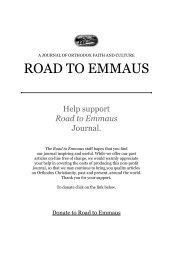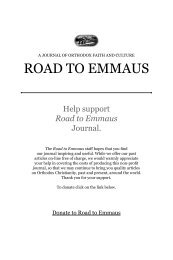RTE No 20 Interior - Road to Emmaus Journal
RTE No 20 Interior - Road to Emmaus Journal
RTE No 20 Interior - Road to Emmaus Journal
Create successful ePaper yourself
Turn your PDF publications into a flip-book with our unique Google optimized e-Paper software.
CHRIST, THE MEDICINE OF LIFEterrors and monsters. The Odyssey mentions two kinds of dead. First, thehuman souls (of every sort) who wander without punishment but are weariedby their memories of life. Their existence is shadow-like, they lament the factthat they have had <strong>to</strong> leave their dear ones, or if they died young, that theydid not live long enough <strong>to</strong> enjoy their lives; their spirits are appeased if sacrificesand libations are offered for them on their graves. Some authors(among them Pseudo-Clement) mention that the land of the dead is in thewest or on the western side of the Ocean (“Ocean” was a mythic notion, aswell). Also in Hades were the superhuman rebels (the so-called “Titans”) sentenced<strong>to</strong> undying exertions for insubordination <strong>to</strong> Zeus and transgression ofthe divine order. Actually, in Greek mythology the Titans were beneathHades in Tartarus, a fearful dungeon. Only later does the idea of the ElysianFields (or Elysium) appear. This is the land of the virtuous dead and ofheroes, who enjoy abundance and beauty after their earthly death.In the patristic times these pagan ideas about Hades were abandoned, orrather, transformed. However, the name of the place often remained in Greekwritings: Hades was the place where everyone went after their death, awaitingthe Last Judgement, although the Christian view of this state differed greatlyfrom that of the ancient Greeks. The concept of Hades as the place where soulsgo after death appears in the Septuagint as the Hebrew “Sheol.”Sheol appears in the Hebrew-language Bible as a proper name, without anarticle, and it is apparently feminine 12 in Is. 5:14; 14:9; Ps. 86:13; and Job26:6. The whole earth is seen as Sheol’s belly (Ex. 15:12). Sheol has manydisguises. It was often called a pit, which was usually imagined as a vast subterraneancave with a narrow mouth like a well. It was also called a prison,a fortified city, and we hear of the “miry waters of Sheol.”In Hebrew usage (and later also in Syriac), Sheol and Death refer <strong>to</strong> thecondition of diminished life. Sheol means danger, illness, death. Life meansfertility, light and order. Just the fact of being alive had moral qualities foran ancient Jew, and the idea of the living God and the abode of the deadessentially exclude each other in Hebrew thought. Just as the fullness of lifeimplies the presence of Yahweh, so the sojourn in Sheol connotes Hisabsence. Sheol is Sheol because the living God is not there.Death and God’s grace excluded each other in this outlook. In dying, aman lost his full relationship <strong>to</strong> God, which explains the complaint that thedead cannot praise Yahweh. Even the righteous went <strong>to</strong> Sheol after their12 Nicholas J. Tromp, Primitive Conceptions of Death and the Nether World in the Old Testament, Rome: 1969.St. Issac the Syrian29










